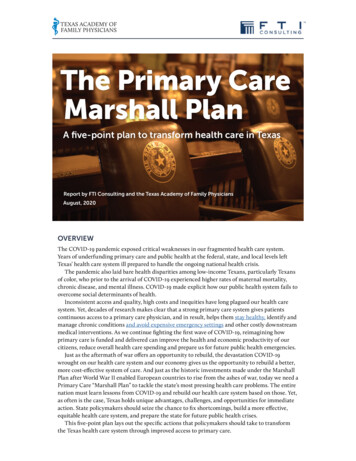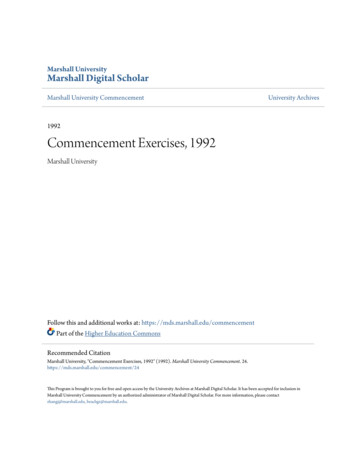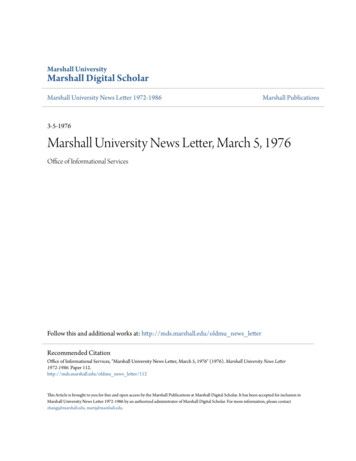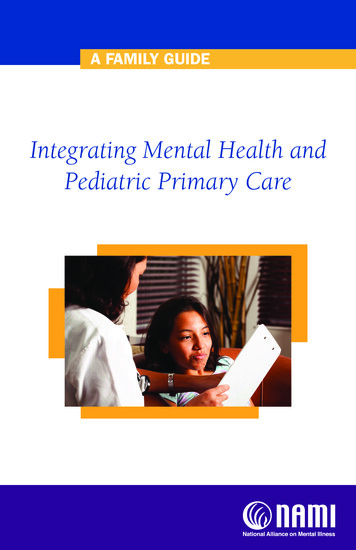
Transcription
The Primary CareMarshall PlanA five-point plan to transform health care in TexasReport by FTI Consulting and the Texas Academy of Family PhysiciansAugust, 2020OVERVIEWThe COVID-19 pandemic exposed critical weaknesses in our fragmented health care system.Years of underfunding primary care and public health at the federal, state, and local levels leftTexas’ health care system ill prepared to handle the ongoing national health crisis.The pandemic also laid bare health disparities among low-income Texans, particularly Texansof color, who prior to the arrival of COVID-19 experienced higher rates of maternal mortality,chronic disease, and mental illness. COVID-19 made explicit how our public health system fails toovercome social determinants of health.Inconsistent access and quality, high costs and inequities have long plagued our health caresystem. Yet, decades of research makes clear that a strong primary care system gives patientscontinuous access to a primary care physician, and in result, helps them stay healthy, identify andmanage chronic conditions and avoid expensive emergency settings and other costly downstreammedical interventions. As we continue fighting the first wave of COVID-19, reimagining howprimary care is funded and delivered can improve the health and economic productivity of ourcitizens, reduce overall health care spending and prepare us for future public health emergencies.Just as the aftermath of war offers an opportunity to rebuild, the devastation COVID-19wrought on our health care system and our economy gives us the opportunity to rebuild a better,more cost-effective system of care. And just as the historic investments made under the MarshallPlan after World War II enabled European countries to rise from the ashes of war, today we need aPrimary Care “Marshall Plan” to tackle the state’s most pressing health care problems. The entirenation must learn lessons from COVID-19 and rebuild our health care system based on those. Yet,as often is the case, Texas holds unique advantages, challenges, and opportunities for immediateaction. State policymakers should seize the chance to fix shortcomings, build a more effective,equitable health care system, and prepare the state for future public health crises.This five-point plan lays out the specific actions that policymakers should take to transformthe Texas health care system through improved access to primary care.
IMPACT OF COVID-19 ON PRIMARYCARE PRACTICESI. PROMOTE COMPREHENSIVE PAYMENTREFORM AND TRANSITION AWAY FROMFEE-FOR-SERVICEA June survey of about 500 clinicians by the Larry A. GreenCenter and the Primary Care Collaborative found 63% of primary care practices were experiencing severe or near severestress, 5% were either temporarily or permanently closed,and 39% needed to layoff or furlough clinicians or staff. Thismarks an improvement from the end of May, when 14% ofpractices were temporarily closed, 1% were permanentlyclosed, and 56% had a significant decrease in patient volume.Over a quarter of practices received financial support fromthe federal government, yet the stress factors persist.When COVID-19 first emerged in the U.S., local stay-at-homeorders and widespread fear kept patients at home, and revenuesfrom in-person visits to physician practices shrank. Most practicesembraced telemedicine, but virtual visits did not generate enoughrevenue to cover operating expenses. Because most primary carepractices keep less than two months of cash on hand, the pandemicfinancially devastated these small businesses. With the pandemic farfrom over, primary care practices remain economically tenuous.Among practices that have fared better, many had previouslymoved away from a fee-for-service payment model — where physicians are paid based on the number of services provided, or thenumber of procedures ordered — to a prospective payment system.Health care spending trends are linked to the way we pay for careand incentivize health care providers. Fee-for-service payment systemsreward physicians who deliver high volume, high-cost services whileundervaluing comprehensive, continuous, and coordinated primarycare services. That payment structure has for decades contributed tothe rising cost of health care in Texas and across the country. A reportby the Texas Comptroller’s Office found that health care spendingrose by an average of 19.7% annually from 2011 to 2015, comprising43.1% of Texas’ state budget in fiscal year 2015. At the same time,reimbursement for high value, cost-effective primary care services hassignificantly declined relative to high-cost imaging and surgical procedures. Care coordination and patient navigation has been reimbursedinadequately, if at all.Today, experts across the political spectrum agree that reformingthe way we pay for care to incentivize quality over quantity couldcontain ballooning health care costs and improve patient outcomes.During the first wave of COVID-19, practices that depended onpatient volumes suffered financially. By contrast, physicians operating under prospective payment systems remained viable businessesand nimble in the care they provided their patients during thisunprecedented challenge. The difference offers a stark contrast andpresent-day case study for some of the pitfalls of fee-for-service careand the advantages of alternative payment models.Physicians operating under prospective payment systems are generally paid a set amount per patient rather than per service. The payment covers a defined set of services and is issued at regular intervals,typically monthly. This approach is not new; in fact, the Centers forMedicare and Medicaid Services already uses a prospective paymentmodel in the Medicare program for acute care hospital inpatientstays. The payment model is one of the hallmarks of success forMedicare Advantage plans. State Medicaid programs, including ahandful of managed care organizations in Texas Medicaid, also useprospective capitated payments in managed care.Similar to products like Netflix, prospective payment models offerconsumers subscriptions to different platforms, with different contentand price structures. While there are numerous prospective paymentmodels, partial capitation — in which physicians are paid a set payment amount for a fixed set of services and take on some risk to keeptheir patients healthy — is where primary care physicians can thrive.Prospective payments reward strong care management andbetter continuity of care for patients, incentivize physicians to keeppatients healthy, and are proven to improve quality while reducingspending. If the state embraced prospective payment, the healthcare system’s foundation, primary care, would be on better financialfooting, able to address everyday needs of patients and respond topublic health emergencies.To encourage adoption of prospective payment systems in Texas,lawmakers should:1. Engage private employers and local governments.In Texas, 47% of individuals receive health insurance throughtheir employer. Over the last decade, employers’ insurance costs rosealmost 51%. In 2018, employers paid 15,159 on average in premiumsfor a family of four. Moving to prospective payments would reducecosts for companies across the state by improving care coordinationand patient outcomes. The same applies to local and municipal governments insuring their employees.Texas legislators should create a multi-stakeholder working groupto implement a voluntary prospective payment model for primarycare physicians. The group should include representatives frombusiness groups, state health agencies, private insurers, primary carephysicians, and consumers. COVID-19 has taught us lessons and created momentum for reform. While individual insurers and employerscan adopt this model on their own, the ability to design and scalea cohesive prospective payment strategy without fear of anti-trustviolations is critical. The Legislature should protect this group’s freedom to collaborate without fear of antitrust violation by includingantitrust protections in statute.Such collaboration and protection are not unprecedented; anumber of other states are already tackling cost, quality and paymentreform. In 2011, the Washington State Legislature established the Dr.Robert Bree Collaborative, which created a mechanism in statute forboth public and private stakeholders to work together on health carequality, outcomes, and cost effectiveness. Each year, the governor ofWashington appoints members to a workgroup representing publicand private health care purchasers as well as plans, physicians, andquality improvement organizations. The group identifies areas ofhigh variation in care delivery and cost, and then makes recommendations to the Washington State Health Care Authority to inform thestate’s purchasing decisions for Medicaid and the Public EmployeesBenefits Board Program. While the recommendations are nonbinding, the Bree Collaborative is an example of successful collaborationto represent diverse interests. This working group also benefitsfrom antitrust protection and immunity from federal antitrust lawsthrough the state action doctrine, as granted by the state legislature.2
Experts across the political spectrum agree that reforming the waywe pay for care to incentivize quality over quantity could containballooning health care costs and improve patient outcomes. Duringthe first wave of COVID-19, practices that depended on patientvolumes suffered financially. By contrast, physicians operatingunder prospective payment systems remained viable businessesand nimble in the care they provided their patients during thisunprecedented challenge.number has grown significantly, with an estimated 660,000 moreTexans losing employer-sponsored coverage. Insurance coveragehelps individuals mitigate financial hardship caused by medical needsand expands their access to physicians . Without coverage, manyindividuals end up in emergency departments for preventable conditions because they avoid or are unable to access routine medical care.Moreover, this population often faces food insecurity and lack oftransportation, examples of what are known as social determinantsof health — non-medical factors that contribute to poorer healthoutcomes and higher costs.Many Texans with health insurance coverage are underinsured —their out-of-pocket health care costs (excluding premiums) are morethan 10% of their income, or 5% for those who are below 200% of thefederal poverty level. As such, underinsured individuals often avoidor delay care due to costs.Finally, Texas is geographically diverse with a significant numberof rural communities. For rural Texans, long distances to urban healthcare centers limit residents’ access to both primary care and specialists.Similarly, Texans living in urban areas may struggle to obtain primarycare when it is not conveniently located close to home or work. Ensuring access to primary care and the coordination of medical care for allthese vulnerable populations can help save Texas valuable health caredollars while also improving health outcomes.With the anticipated renewal of its Medicaid 1115 Transformationwaiver, as well as other federal flexibilities to make health care coveragemore affordable, opportunities abound to put forward a proposal to theCenters for Medicare and Medicaid Services to test innovative deliverysystem and payment models to improve access to care for all Texans.Legislators should consider market-based solutions available tosupport care for these groups including:Governors across the country are exercising their executiveauthority to lower health care costs while promoting high-value care.As of February 2020, 21 governors outlined plans to improve healthcare affordability and quality in their state. In addition to workingwith the Legislature, Gov. Abbott should establish a workgroup orcollaborative to prioritize these issues.2. Encourage state-funded health plans and Medicaid toimplement prospective payment.Texas should institute a legislative or budgetary directive requiring Texas’ Employees’ Retirement System and Teachers’ RetirementSystem to offer prospective payment and other alternative paymentoptions to interested primary care physicians and clinics. Collectively, these plans cover more than five million Texans.Additionally, ERS and TRS should be encouraged to offer someform of direct contracting for primary care services as a benefit option.New Jersey and Nebraska recently implemented direct primary care intheir state health plans. While the programs are relatively new, bothstates expect savings and improvements in health outcomes as a result.Texas Medicaid already requires Medicaid managed care plans topromote value-based payment arrangements, including prospectivepayments, among network physicians. Small physician practices oftenstruggle to implement such systems because they lack the technicalexpertise and financial resources. Texas could facilitate broader adoption of alternative payment models among primary care physicians byimplementing a monthly per-member, per-month payment to offsetupfront costs of practice transformation, better aligning Medicaidperformance and outcome measurers with other payers, paying forcare coordination and chronic care management, and promoting physician-led accountable care organizations to help organize and supportindependent physician practices with data analytics, care coordinationand other key elements of value-based payment arrangements.1. Creating a tailored solution to expand Medicaid.The Medicaid program is an important safety net for low-incomeadults in Texas. Legislators should reconsider expanding Medicaidunder the Affordable Care Act to take advantage of federal incentivesand curb the state’s climbing uninsured rate due to the COVID-19 pandemic. Expanding Medicaid in Texas would provide 1.5 million low-income working Texans access to health care coverage. At the same time,Texas has considerable flexibility to design a program best suited for itspopulation, including designing the benefit package and establishingpatient cost-sharing. Increasingly, policymakers on both sides of theaisle recognize the pressing need to expand health care coverage andsupport access to care among vulnerable, low-income populations.II. MARKET BASED APPROACHES TODECREASING THE UNINSUREDRelative to the federal government, states have wide latitude toindividually test and implement new health care coverage initiativesfor their populations, which may in turn demonstrate national applicability. As the second most populous state in the country, Texas hasthat power in higher measure.Prior to the pandemic, 18% of Texans lacked health care coverage — twice the national average. However, since February that3
tions and prevent complications, especially the chronically ill. Afterimplementing DPC through Iora Health, workers in the Las VegasCulinary Union experienced lower inpatient admissions by 37% andlower health care spending by 12%, compared to control groups outside the practice. Through DPC, Atlantic City hotel workers reducedtheir total health care spending by 12.3%. In both Las Vegas andAtlantic City, fewer hospital admissions, emergency room visits, andoutpatient procedures explained the considerable savings.DPC is not considered health insurance and therefore doesnot enjoy the federal tax advantages of traditional health plans,so cost-effective implementation remains challenging. Becauseindividuals still require emergency or specialty care not offered by aprimary care practice, as well as protection from catastrophic healthcare costs, employers often offer DPC to supplement other insuranceplans. A model including DPC must be paired with more affordablecoverage options for purchasers to recognize substantial savings. Toincrease access, Texas should create an avenue to allow for the sale ofcatastrophic insurance coverage when offered in combination withDPC. Generally available only to those under 30, Texas could developa pilot program through a 1332 State Relief and EmpowermentWaiver to classify catastrophic coverage purchased in conjunctionwith DPC as qualifying health coverage for individuals of all ages.The pilot could determine whether this combination structure leadsto improved access to care, improved health outcomes, and loweroverall costs.2. Pursuing innovative, market-based approaches to reducethe ranks of the uninsured.Apart from Medicaid, a handful of innovative and market-basedapproaches could decrease Texans’ uninsured rate. Legislatorsshould examine existing programs and consider how the state’s 1115Medicaid Transformation waiver could be used to support vulnerablepopulations lacking insurance.Community Accountable Care OrganizationsAs Texas seeks to renew and reimagine its Medicaid waiver, set toexpire in 2022, the state should aim for a community-centric modelfocused on an inclusive delivery system that fosters participation byphysicians, hospitals and other health care providers interested inserving the population. Consider the Community Accountable CareOrganization model, which organizes a varied network of healthcare providers under a single, community-based board. The model,employed in Washington, Oregon, Colorado, and North Carolina,uses value-based payment approaches to improve population health,a holistic model to address social determinants of health alongsidemedical issues. Ideally, Texas would implement the model statewide,but a preliminary step could be to pilot select Community ACOs incities and towns across the state. The Dallas County Medical Societyhas proposed one city-specific example of a community ACO, theDallas Choice Plan, which would establish a partnership with thelocal Parkland Health and Hospital System as a starting point. Legislators could consider this plan as a model to build upon.4. Greater regulatory power and data collection to promote acompetitive, transparent, consumer-friendly health insurance market.Charity Care ProgramsCharity-based programs like Project Access coordinate care forat-risk individuals. Similar programs are proven to improve careand lower spending. Under the Project Access program, a group ofphysicians and other health care workers joined forces with programcoordinators and community clinics to provide charity care for a setnumber of vulnerable and low-income patients each year. Patientsgained access to a care team who ensured they received follow-up careand assistance with transportation and translation services. Thesecare coordination services lowered hospital costs by 60% compared tosimilar patients outside the program. Unfortunately, Dallas MedicalSociety discontinued Project Access in 2013 due to funding constraints.Legislators should consider reestablishing this program statewide.Texans deserve a competitive health insurance marketplace,and this is possible when the market is transparent and consumerfriendly. As consolidation means health care markets become concentrated, research suggests that prices rise and health outcomessuffer. To protect competition, Texas might look to California wherelegislation gives the state Attorney General the authority to regulatemergers among nonprofit health care systems. Furthermore, theCalifornia AG is also seeking greater authority to regulate for-profithealth care systems. Texas legislators should empower the state AGwith both of these authorities to ensure a competitive marketplaceand protect consumers.Consumers can also enable a more competitive marketplace whenthey are equipped to shop for care based on price and quality. That iswhy Texas should work toward a statewide all payer claims database,or APCD, a centralized database that collects medical, pharmacy, anddental claims data from public and private sources. This data is usedby researchers and policymakers to identify and launch initiativesto improve quality and health outcomes, while also lowering costs.Among a broader consumer audience, patients can use the APCDto discover how much services cost across physicians, providers, facilities, and locations while shopping for health care.The largest claims database in Texas is currently the Center forHealth Care Data housed at the University of Texas School of PublicHealth in Houston, which collects health care utilization data foralmost 80% of Texas’ population. Today, the data center’s capabilitiesare limited by the volume and type of data that they receive; privateinsurers are not required to provide the center claims data. To implement a robust APCD, Texas should leverage the existing infrastructure at UT Health and designate the Center for Health Care Data asRural Community Health SystemIn 1997 Texas legislators authorized the Rural Community HealthSystem, establishing a nonprofit insurance entity governed by a community board of rural physicians, hospital administrators, employersand community leaders. By banding together as one insurance entity,these networks could compete against bigger, urban networks, orMedicaid managed care, thus keeping dollars spent on health carewithin their communities. Legislators should consider this existingframework to support Texans in rural communities.3. Fostering direct contracting for primary care services.Texas should foster direct contracting for primary care servicesthrough direct primary care. In the DPC model, a physician is paidmonthly, quarterly, or annually by an individual or employer totreat all or most of a patient’s primary care needs. DPC is growing inpopularity because it prevents unnecessary interventions, promotestransparent pricing, and helps patients better manage their condi4
Prior to the pandemic, 18% of Texans lacked health care coverage— twice the national average. Since February that number hasgrown significantly, with an estimated 660,000 more Texans losingemployer-sponsored coverage. Many of these individuals end up inemergency departments for preventable conditions because theyavoid or are unable to access routine medical care. Moreover, thispopulation often faces food insecurity and lack of transportation,examples of social determinants of health.As noted above, prospective payments give physicians theflexibility to transition to new care modalities like telemedicinewithout upending their business operations. Physicians engagedin alternative payment models prior to the public health emergency were able to overcome initial financial stresses caused by thepandemic. According to a Premier Inc. survey, 82% of alternativepayment model participants were able to leverage care management supports to manage their COVID-19 patients while only 51%of those in fee for service were able to do the same. Payment policies, like prospective payments for primary care, help physiciansfocus on caring for their patients without anxiety over reimbursement for a particular modality.Texas legislators should act to implement and push for prospective payments for interested primary care physicians and practices.Legislators should:the state’s official APCD and require all payers to report claims data.By doing so, the state would empower consumers to actively shop forcare in a competitive, transparent marketplace.III. ACCELERATE THE TRANSITION TOTELEMEDICINEOnce considered a tool to connect rural patients and small physician practices and community clinics with specialists, COVID-19has demonstrated the broad applicability of telemedicine for bothpatients and physicians. Texas distinguishes between telemedicineand telehealth. Videoconferences, telephone calls and remote monitoring programs connecting patients and physicians are all considered telehealth. Telemedicine refers to a subset of telehealth that specifically addresses medical care, diagnostic and prescription writingservices. Primary care practices that adeptly integrated telemedicineservices during the pandemic fared better than those that didn’t.Despite arguments that promoting virtual care could lead toincreases in health care use, telemedicine has been shown to saveas much as 1,500 per visit by keeping patients out of the emergency department. In certain specialties like primary care, increasedtelemedicine use is associated with decreases in overall health carespending and hospitalizations.Historically, virtual care models for payment and use vary widelyacross the country, and even within state lines. The COVID-19pandemic transformed the telemedicine landscape, with publicpayers and private health plans expanding covered services andallowing for payment parity between in-person and virtual visits. Themarket research firm Arizton projects that the telehealth market willexperience 80% year-over-year growth due to COVID-19. A surveyby FTI consulting finds that this trend is unlikely to reverse, with51% of Americans reporting they are more likely to use telemedicineoptions, even after the pandemic subsides.COVID-19 led to the adoption of telemedicine at an incrediblepace, but it also exposed shortfalls of its predominantly fee-for-service payment system and demonstrated that telemedicine worksbest when provided in the context of an existing patient-physicianrelationship. Under these circumstances, physicians and patientswere able to transition seamlessly into a new care modality, in manycases made possible by the flexibility provided under a prospectivepayment model. Many recent reforms to telemedicine payment andcoverage remain temporary. Lawmakers must take steps to ensureongoing telemedicine access in Texas after the present public healthemergency subsides.1. Adopt Medicare’s telehealth flexibilities for consistency andalignment to ease administrative burden for practices.Many physicians treat patients covered by various insuranceplans, and do not differentiate between sources of coverage whenworking to care for their patients. When ERISA, commercial orstate-based plans do not align with the nation’s largest payer, Medicare, physicians spend precious hours pursuing reimbursementfrom different payers. During COVID-19, many payers aligned theirpolicies with Medicare, which helped ease administrative burdenson physicians. Current policies should be made permanent, like theallowance for patients to receive telehealth services in their home;coverage and payment parity for telephone evaluation and management services; coverage of e-visits and virtual check-ins; anddocumentation flexibilities that mirror the 2021 Medicare changes,which allow physicians to classify visits based on total time or medical decision-making.2. Adopt telehealth policies that are integrated into a patient’susual source of primary care, rather than restricting telehealth access to designated telehealth partners.Research shows that patients with regular access to theirprimary care physician have lower overall health care costs andimproved health outcomes. Telehealth can enhance the doctor-patient relationship and improve patient and physician satisfaction.Physicians can grow familiar with patients when seeing them in ahome setting, learning information unavailable during an in-person visit. When telehealth services are provided by physicianslacking a relationship with a patient, such as through a third-party5
platform, those benefits are lost. Texas should encourage payersto adopt telehealth policies that support established relationshipsbetween a patient and their primary care physician ensuring continuity of care.has diverted funding from the program and limited participation.Instead, the Legislature should increase funding, maximize participation in the program, and renew its commitment to increase access tocare for Texans in rural and underserved communities.3. Recognize that telehealth is a part of many methods todeliver care, not a standalone modality.2. Support recent expansion in family medicine residencytraining by appropriately funding the Family Practice Residency Program.Telemedicine is not just a point of care solution; it is one toolin a toolbox available to providers to help patients maintain andimprove their health. It is an excellent option to deliver care, but itshould not be the only source of communication between patientsand physicians with an existing relationship. The success of virtualcare can vary based on a patient’s personal needs, something theirprimary care physician is best fit to assess. Texas should discouragetelehealth-only benefit plans, which eliminate a crucial componentof care. Instead, payers should alter payment structures to incentivizecontinuous coordinated care.Texas operates 36 nationally accredited family medicine residencyprograms, which train the next generation of family physicians. Acombination of federal and state monies sustains these programs,which have been funded for decades through the Texas HigherEducation Coordinating Board. Although many of these programsreceive some benefit from federal Direct Graduate Medical Educationand through their sponsoring institutions, dedicated CoordinatingBoard funds are the only direct state support they receive.In 2017, the Texas State Legislature cut the Family PracticeResidency Program, or FPRP, by 40%, reducing its annual budgetto just 5 million. With the passage of Senate Bill 18 in 2015, theLegislature expanded residency training capacity, including fivenew family medicine residency programs. While commendable,the expansion, coupled with funding cuts in 2017, thinned FPRPper-resident funding even more. In 2017, the FPRP provided residency programs with 10,728 for each of the 761 family medicineresidents in training. In 2021, it will provide only 5,485 per resident for 874 family medicine residents.This program works. The most recent Texas Higher EducationCoordinating Board Budget Strategy notes that 70% of family physicians who complete their residency in Texas practice in the state. TheLegislature should increase funding to the Family Practice ResidencyProgram to the annual level of at least 10,000 per resident.IV. RECALIBRATE AND OPTIMIZE TEXAS’PHYSI
Prospective payments reward strong care management and better continuity of care for patients, incentivize physicians to keep patients healthy, and are proven to improve quality while reducing spending. If the state embraced prospective payment, the health care system's foundation, primary care, would be on better financial











